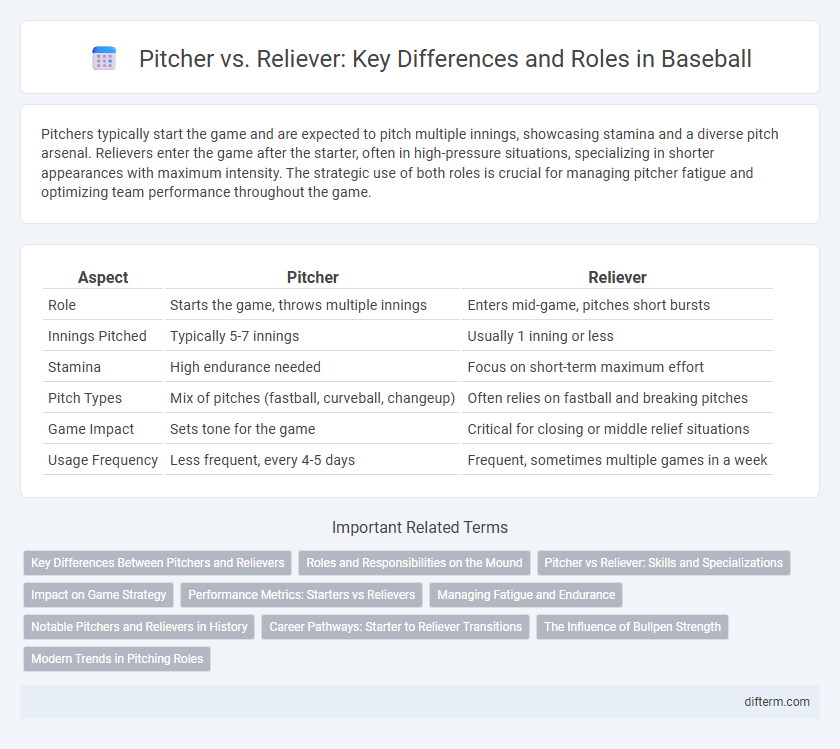Pitchers typically start the game and are expected to pitch multiple innings, showcasing stamina and a diverse pitch arsenal. Relievers enter the game after the starter, often in high-pressure situations, specializing in shorter appearances with maximum intensity. The strategic use of both roles is crucial for managing pitcher fatigue and optimizing team performance throughout the game.
Table of Comparison
| Aspect | Pitcher | Reliever |
|---|---|---|
| Role | Starts the game, throws multiple innings | Enters mid-game, pitches short bursts |
| Innings Pitched | Typically 5-7 innings | Usually 1 inning or less |
| Stamina | High endurance needed | Focus on short-term maximum effort |
| Pitch Types | Mix of pitches (fastball, curveball, changeup) | Often relies on fastball and breaking pitches |
| Game Impact | Sets tone for the game | Critical for closing or middle relief situations |
| Usage Frequency | Less frequent, every 4-5 days | Frequent, sometimes multiple games in a week |
Key Differences Between Pitchers and Relievers
Pitchers typically start the game and aim to pitch multiple innings, relying on stamina and a diverse pitch arsenal to face batters repeatedly. Relievers, on the other hand, enter the game later and usually pitch fewer innings, emphasizing high velocity and specific situational matchups to quickly neutralize hitters. The key differences lie in their roles, endurance requirements, and strategic usage within a team's bullpen management.
Roles and Responsibilities on the Mound
Pitchers are primarily responsible for starting the game and facing the opposing team's batters, aiming to control the tempo and establish dominance on the mound through a mix of pitch types and strategic placement. Relievers enter the game later, often in high-pressure situations, to maintain leads or keep the score close by delivering effective, specialized pitching in shorter stints. Both roles require precise command, mental toughness, and an understanding of batter tendencies to maximize team success.
Pitcher vs Reliever: Skills and Specializations
Pitchers and relievers in baseball exhibit distinct skills and specializations tailored to their roles on the mound. Starting pitchers rely on endurance and a diverse arsenal of pitches to navigate multiple innings, while relievers specialize in high-velocity pitches and situational effectiveness during shorter appearances. Mastery in control, velocity, and mental toughness differentiates a starting pitcher's ability to pace the game from a reliever's capacity for rapid, high-pressure impact.
Impact on Game Strategy
Starting pitchers set the tone by facing the opposing lineup multiple times, allowing teams to build a foundational game strategy around their endurance and pitch selection. Relievers specialize in specific innings or situations, enabling managers to exploit matchups and preserve leads through high-leverage performances. The strategic interplay between starters' stamina and relievers' situational effectiveness shapes bullpen usage and game outcomes in modern baseball.
Performance Metrics: Starters vs Relievers
Starters typically accumulate higher innings pitched and strikeouts per game, emphasizing endurance and consistency, while relievers excel in strikeout rates per inning and leverage situations, showcasing effectiveness in high-pressure moments. Advanced metrics such as Fielding Independent Pitching (FIP) and Win Probability Added (WPA) often highlight relievers' ability to influence game outcomes in short bursts. Comparing ERA and WHIP, starters' performance trends towards sustained control, whereas relievers maintain volatility but impact key innings significantly.
Managing Fatigue and Endurance
Pitchers and relievers have distinct roles that impact how they manage fatigue and maintain endurance throughout the game. Starting pitchers require careful pacing and recovery strategies to sustain multi-inning performance, often using pitch counts and scheduled rest days to prevent overuse injuries. Relievers rely on short, high-intensity outings, demanding quick recovery protocols and situational deployment to optimize energy and effectiveness.
Notable Pitchers and Relievers in History
Notable pitchers such as Nolan Ryan and Sandy Koufax revolutionized the game with their dominant starting performances and record strikeouts. Relievers like Mariano Rivera and Trevor Hoffman redefined bullpen roles by consistently closing games with high save totals and exceptional control. Both groups have left an indelible mark on baseball history, showcasing the strategic importance of pitching specialization.
Career Pathways: Starter to Reliever Transitions
Pitchers often transition from starters to relievers to extend their careers and manage workload, especially when facing declining velocity or endurance. This shift allows them to focus on shorter outings, leveraging specialized pitches and high-intensity efforts that maximize effectiveness in relief roles. Teams strategically move pitchers to the bullpen to capitalize on their experience while addressing roster needs and optimizing pitching staff depth.
The Influence of Bullpen Strength
Bullpen strength significantly impacts game outcomes, as a strong reliever unit can maintain leads and suppress opposing offenses after the starting pitcher exits. Effective relievers with high strikeout rates and low ERA minimize the opposing team's scoring opportunities, directly influencing win probabilities. Teams with durable, specialized relievers often outperform those relying solely on starters, emphasizing the strategic value of bullpen depth in modern baseball.
Modern Trends in Pitching Roles
Modern pitching roles emphasize specialized use of pitchers, with starters often limited to fewer innings to preserve stamina and effectiveness. Relievers, including setup men and closers, are increasingly deployed in high-leverage situations earlier in games to maximize strategic advantage. Advanced analytics guide managers in optimizing pitcher matchups, enhancing overall team performance.
Pitcher vs Reliever Infographic

 difterm.com
difterm.com